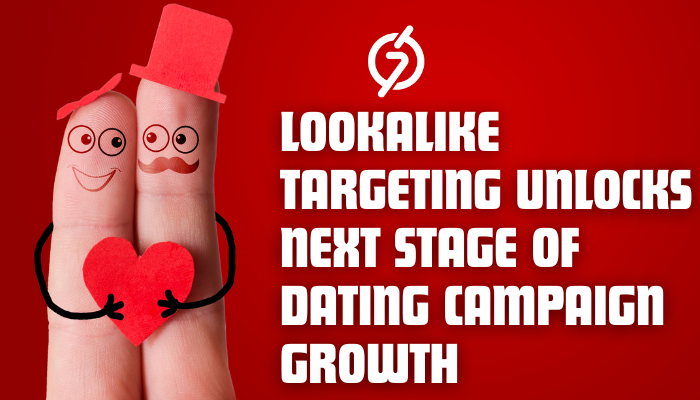If you’ve ever wondered why some Dating Campaigns grow consistently while others stall after early wins, the answer often lies in how advertisers scale their audience targeting. Many campaigns reach a point where cost per acquisition spikes, engagement drops, and the once-promising click-through rates start flattening. That’s where lookalike targeting quietly steps in—an underused yet powerful way to unlock sustainable growth in dating advertising.
Real growth starts beyond your core audience
Advertisers running online dating campaigns often start strong with interest-based or behavioral targeting. But once that pool saturates, performance plateaus. According to Meta’s ad benchmark reports, lookalike audiences deliver 3–5x higher conversion potential when built from high-quality first-party data compared to cold targeting.
This method allows advertisers to go beyond existing users without shooting in the dark. You’re not just guessing who might click—you’re reaching people who actually act like your top converters.
Scaling without losing quality
Every dating advertiser knows the pain of scaling too fast. When your cost per lead jumps and conversion rates tumble, it’s often because your expanded audience isn’t aligned with your original intent. For dating verticals, this problem is even sharper.
Unlike e-commerce or gaming, dating ads rely on emotional engagement—the right image, the right tone, the right promise. So, when you expand reach too broadly, you risk losing resonance. A wider audience doesn’t always mean a better one.
That’s the core challenge: how do you grow without breaking the campaign’s emotional thread?
Lookalike targeting turns data into intuition
Smart advertisers use lookalike targeting to do just that. Think of it as transforming your existing success data into a blueprint for finding more of the same. Instead of spending on audiences that might convert, you’re teaching the algorithm what success looks like.
Let’s say your last campaign performed exceptionally with singles aged 25–34 who interacted with your “Find Real Connections” ad creative. You can feed that data back into your ad platform, and it will identify similar users—people with parallel engagement patterns, demographics, and behavior traits.
This strategy is not about replacing manual targeting. It’s about using machine learning to enhance it.
Why smarter ad approaches scale better
You can’t scale dating ads effectively without data-driven precision. Lookalike targeting bridges creativity with conversion intelligence. It helps advertisers build campaigns that learn, evolve, and self-correct over time.
But this strategy works only if your foundation is strong. You need accurate event tracking, clear funnel goals, and clean audience data. That’s how you teach ad networks who your “best match” actually is.
Once your lookalike model starts running, you’ll notice smoother cost stability and fewer random spikes in acquisition costs. It’s like giving your campaign a growth compass—it doesn’t just chase volume; it pursues quality.
For example, optimizing creative variations for Optimize Ad Spend for Maximum ROI in Dating Campaigns often pairs perfectly with lookalike targeting. Together, they help reduce wasted impressions while boosting overall campaign profitability.
How lookalike targeting works in dating advertising
Most major ad platforms—like Meta, Google, and native ad networks—let you create lookalike audiences based on source data. That source could be your existing site visitors, leads, signups, or even your most engaged in-app users.
Here’s a quick rundown:
- Upload a seed audience: Usually 1,000–5,000 top converters from your previous campaign.
- Choose lookalike size: Smaller audiences (1–2%) are closer to your seed and tend to perform better. Larger audiences (5–10%) expand reach but can dilute accuracy.
- Test multiple lookalike sets: Segment by behavior, not just demographics. For instance, one group could be “active users,” another “first-time signups.”
- Refresh data regularly: Outdated audiences lead to declining performance. Rebuild lookalikes every few weeks based on fresh data.
When executed well, this method not only grows traffic but also improves downstream conversions—because it attracts people already primed to act like your best users.
How advertisers apply this to real dating ad campaigns
Let’s look at a practical example. A dating advertiser running a campaign for a mature singles platform noticed their engagement plateau after week six. They used their best-performing 1,500 users (those who signed up and messaged within the app) as the seed for a 1% lookalike audience.
The result? Their conversion rate increased by 38% within three weeks, and cost per lead dropped by 22%.
That’s not magic—it’s machine learning guided by human logic.
Combining lookalike targeting with creative rotation
Your lookalike audience is only as effective as the message it receives. If your creatives don’t align with their motivations, you’ll waste impressions.
Dating campaigns that perform best use creative rotation—a system that tests ad visuals and copy tailored for different emotional triggers. For example, some audiences respond to “authentic connections,” while others engage more with “fun and casual meetups.”
When you combine this with lookalike targeting, your campaign can adapt dynamically. You’re essentially saying, “Find me people who act like my best users—and show them the creative they’re most likely to love.”
Why advertisers trust data-driven audience expansion
What makes lookalike targeting so powerful isn’t just efficiency—it’s predictability. Advertisers no longer rely on intuition alone. They can forecast how ad networks will scale and budget ad campaigns accordingly.
This is especially useful in Dating Campaigns where audience behavior changes quickly. Seasonal shifts, trending app features, and even regional dating norms can influence engagement. Lookalikes help stabilize that unpredictability.
They ensure that even when market conditions change, your campaigns stay connected to people who resemble your top-performing segment.
Avoiding the common mistakes
Many advertisers jump into lookalike targeting too early or without cleaning their data. That’s a costly mistake. The better your base data, the more accurate your audience expansion will be.
Here are three pitfalls to avoid:
- Using too small a seed audience. Below 1,000 users, algorithms struggle to find reliable patterns.
- Mixing engagement types. Don’t combine leads and inactive users; it confuses the model.
- Neglecting creative personalization. Lookalikes mirror behavior, not taste—your ad still has to speak their language.
Once you correct these, your campaigns will start showing consistent improvements in cost efficiency and engagement quality.
Turning lookalike data into ongoing growth
The beauty of this approach lies in iteration. Lookalike targeting is not a one-time tactic—it’s a cycle of data refinement. Each campaign produces new insights you can feed back into your system.
If your CTRs are dropping, test a smaller audience. If conversions are stable but growth is slow, expand slightly. Over time, you’ll develop an instinct for how wide to cast your net without losing quality.
Advertisers who master this balance often see compounding results. Instead of chasing short-term spikes, they build sustainable reach that supports every stage of their funnel.
Where to take it from here
If you’ve already tested manual targeting and feel your campaigns have hit a ceiling, it’s time to step into smarter audience expansion. With lookalike targeting, you can scale responsibly—reaching more users without diluting campaign performance.
And if you’re ready to put these insights into action, it might be time to create a Dating campaign that actually grows with precision and purpose.
Conclusion
Lookalike targeting represents a quiet shift in how advertisers approach dating campaigns. It’s not about chasing volume—it’s about replicating success. By turning user data into a predictive growth engine, you can reach the next stage of scale without sacrificing connection or quality.
For advertisers in the dating vertical, this might be the most reliable path toward predictable, measurable, and sustainable campaign growth.
 :
https://www.pinterest.com/7search_ppc_ads/
:
https://www.pinterest.com/7search_ppc_ads/

